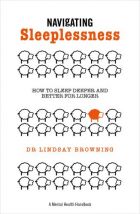Navigating Sleeplessness: How to Sleep Deeper and Better for Longer (A Mental Health Handbook)

Sleep does not appear much in discussions on development or basic needs; there is no SDG on sleep. A World Health Organization publication on sleep and health notes how sleep is essential for good physical and mental health, good quality of life and good performance during the day. Insomnia is the most common sleep disorder, with 30 per cent of adults globally experiencing short-term insomnia and 10 per cent having long-lasting insomnia and difficulties functioning effectively. The urban poor in the global South can be especially burdened by the problem, however, and numbers there may be much higher. WHO indicates that challenging living conditions, insecure tenure and employment, poverty and cultural dislocation can all mean higher rates of anxiety, depression and the insomnia that so often accompanies them.
A WaterAid project in Dhaka to provide better-quality and more accessible water asked the women who benefitted whether this had helped increase their income-earning time. It had not. But the water collectors described how much the project was appreciated for allowing more sleep, since they no longer had to get up very early and queue for water. And a study in Buenos Aires found that even minimal housing improvements significantly improved sleep quality among the residents of informal urban settlements.
A new book, Navigating Sleeplessness, presents a summary of what is known about sleep, including the different stages of sleep and the interactions with the brain. It describes what constitutes “good” sleep and how much sleep is needed. It describes the range of physical and mental health benefits from getting the right amount of sleep. But it also explains the different sleep disorders that constitute “bad” sleep. Then it discusses the changes that can address insomnia, including changes in diet, exercise and timing of sleep.
The book shows how to keep a sleep diary that builds the information needed to identify and address sleeping problems; it then presents a range of breathing exercises and relaxation programmes. While these simple exercises cannot address the structural problems that contribute to sleeplessness, they provide at least a constructive approach to managing it. The book ends with details of where to find help and other resources.
Book note prepared by David Satterthwaite
Search the Book notes database
Our Book notes database contains details and summaries of all the publications included in Book notes since 1993 - with details on how to obtain/download.
Use the search form above, or visit the Book notes landing page for more options and latest content.
For a searchable database for papers in Environment and Urbanization, go to http://eau.sagepub.com/

